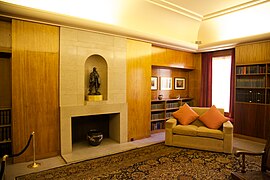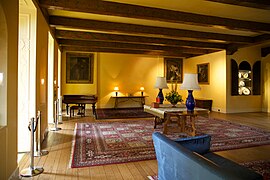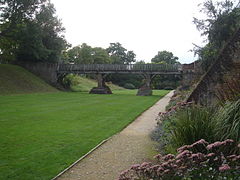Eltham Palace
| Eltham Palace | |
|---|---|
| Coordinates | 51°26′50″N 00°02′53″E / 51.44722°N 0.04806°E |
| Current tenants | English Heritage |
| Owner | Crown Estate |
| Website | |
| www | |
Eltham Palace is a large house at Eltham (/ˈɛltəm/ EL-təm) in southeast London, England, within the Royal Borough of Greenwich. The house consists of the medieval great hall of a former royal residence, to which an Art Deco extension was added in the 1930s. The hammerbeam roof of the great hall is the third-largest of its type in England, and the Art Deco interior of the house has been described as a "masterpiece of modern design".[1] The house is owned by the Crown Estate and managed by English Heritage, which took over responsibility for the great hall in 1984 and the rest of the site in 1995.[2]
History
1300–1930
The original palace was given to
I had been carried off by Thomas More, who had come to pay me a visit on an estate of Mountjoy’s (the house of Lord Mountjoy near Greenwich) where I was staying, to take a walk by way of diversion as far as the nearest town (Eltham). For there all the royal children were being educated, Arthur alone excepted, the eldest son. When we came to the hall, all the retinue was assembled; not only that of the palace, but Mountjoy’s as well. In the midst stood Henry, aged nine, already with certain royal demeanour; I mean a dignity of mind combined with a remarkable courtesy…. More with his companion Arnold saluted Henry (the present King of England) and presented to him something in writing. I, who was expecting nothing of the sort, had nothing to offer; but I promised that somehow, at some other time, I would show my duty towards him. At the time I was slightly indignant with More for having given me no warning, especially because the boy, during dinner, sent me a note inviting something from my pen. I went home, and though the Muses, from whom I had lived apart so long, were unwilling, I finished a poem in three days.
The courtier
The current house was built in the 1930s on the site of the original, and incorporates its Great Hall, which boasts the third-largest hammerbeam roof in England.[9] Fragments of the walls of other buildings remain visible around the gardens, and the 15th-century bridge still crosses the moat.[10]
-
The south side of the palace, with the medieval great hall on the left
-
JMW Turner's painting of the great hall c.1793
-
The great hall in 2018
1930–present
In 1933, Stephen Courtauld and his wife Virginia "Ginie" Courtauld (née Peirano) acquired a 99-year lease on the palace site and commissioned Seely & Paget to restore the hall and create a modern home attached to it. Seely and Paget added a minstrel's gallery and a timber screen to the hall, while creating a design for the main house inspired by Christopher Wren's work at Hampton Court Palace and Trinity College, Cambridge.[11]
The home was decorated internally in the Art Deco style. The entrance hall was created by Swedish designer Rolf Engströmer; light floods in from a glazed dome, highlighting blackbean veneer and figurative marquetry.[12] Other rooms in the house, including the dining room, drawing room and Virginia Courtauld's circular bedroom and adjoining bathroom, were the work of the Italian designer Piero Malacrida de Saint-August, while Seely and Paget designed many of the bedrooms.[11] Keen gardeners, the Courtaulds also substantially modified and improved the grounds and gardens.[13]
-
The Art Deco entrance hall
-
Virginia Courtauld's bedroom
-
The library
-
The dining room
-
The drawing room
Stephen was a younger brother of
The Courtaulds' pet lemur, Mah-Jongg, had a special room on the upper floor of the house which had a hatch to the downstairs flower room; he had the run of the house. The Courtaulds remained at Eltham until 1944. During the earlier part of the war, Stephen Courtauld was a member of the local Civil Defence Service. In September 1940 he was on duty on the Great Hall roof as a fire watcher when it was badly damaged by German incendiary bombs. In 1944, the Courtauld family moved to Scotland then to Southern Rhodesia (now Zimbabwe), giving the palace to the Royal Army Educational Corps in March 1945; the corps then moved all its administration to Eltham Palace in 1948.[15] Following the formation of the Educational and Training Services Branch of the new Adjutant General's Corps, staff moved to Worthy Down Camp in Hampshire in 1992.[16]
In 1995, English Heritage assumed management of the palace, and in 1999, completed major repairs and restorations of the interiors and gardens.[13]
-
Moat
-
Garden
-
South Bridge
Filming
Many films, television programmes and music videos have been filmed at Eltham Palace, including:
- High Heels and Low Lifes (2001)[17]
- The Gathering Storm (2002)[18]
- Bright Young Things (2003)[19]
- I Capture the Castle (2003)[20]
- Death on the Nile, (2004), episode of Poirot TV series[21]
- Revolver (2005)[19]
- Brideshead Revisited (2008)[19]
- Parachute (2010), music video[22]
- Secret Diary of a Call Girl (2011)[22]
- The Crown (2017)[18]
- Stan & Ollie (2018)[19]
- Misbehaviour (2020)[19]
Haunting
Eltham Palace is listed on English Heritage's list of "most haunted places." The ghost of a former staff member is said to have given tours of the palace when the palace should have been empty.[23]
References
- ^ "Eltham Palace". LondonTown.com. Retrieved 3 January 2012.
- ^ "History of Eltham Palace and Gardens Access". English Heritage. Retrieved 31 May 2020.
- Baldwin II, visited the court of Henry III on two occasions, in 1238 and 1247, in search of assistance against the Byzantine successor state of Nicaea. Cf. Matthew Paris, Chronica Majora, ed. H.R. Luard, London: 1872–1883, 7 vols. (Rolls series, 57): vol. 3, 480–481; vol. 4, 625–626.
- ^ Sarah Carpenter, 'Chivalric Entertainment at the Court of Henry IV: The Jousting Letters of 1401', Medieval English Theatre, 43 (D. S. Brewer, 2022), pp. 39-107.
- ^ Collected Works of Erasmus, Toronto University Press, volume 9, letter 1341A. The reference can be found also in R. W. Chambers, Thomas More, 1935, edn 1976, p. 70; E. E. Reynolds, Thomas More & Erasmus, 1965, p. 25, and The Field is Won, The Life and Death of St Thomas More, 1968, p. 35.
- ^ "Through the benefite of the river, a seate of more commoditie", observed Lambarde, in his Perambulation of Kent 1573, noted by Walter Thornbury and Edward Walford, Old and New London: A Narrative of Its History, Its People and Its Places 1893:238.
- ^ a b Thornbury and Walford 1893:239.
- ^ Frederick Devon, Issues of the Exchequer (London, 1836), pp. 106-7.
- ISBN 978-1-873876-15-2.
- ^ Historic England. "North Bridge across Eltham Palace Moat (1218925)". National Heritage List for England. Retrieved 22 September 2020.
- ^ a b "The Partners: Seely and Paget". English Heritage. Retrieved 17 December 2019.
- ^ "Eltham Palace". prop a scene. 2000. Archived from the original on 2 March 2012. Retrieved 3 January 2012.
- ^ a b "The History of Eltham Palace and Gardens". English Heritage. Archived from the original on 2 March 2012.
- ^ "The Sentry, Eltham Palace". Arts and Culture. Retrieved 22 September 2020.
- ^ "The Army at Eltham". English Heritage. Retrieved 15 December 2019.
- ^ "Regimental Association Subscriptions". Retrieved 18 May 2014.
- ^ "High Heels and Low Lifes". British Film Locations. Retrieved 13 October 2022.
- ^ a b "Eltham Palace". Art Deco Lifestyle. 4 February 2020. Retrieved 13 October 2022.
- ^ a b c d e "Greenwich film and TV locations". Visit London. Retrieved 13 October 2022.
- ^ "I Capture the Castle". British Film Locations. Retrieved 13 October 2022.
- ^ "Poirot reveals the past". News Shopper. 18 September 2007. Retrieved 13 October 2022.
- ^ a b "Eltham Palace: Discover what there is to see and do on a visit". News Shopper. 26 August 2018. Retrieved 13 October 2022.
- ^ Copping, Jasper (27 June 2009). "English Heritage reveals most haunted sites". The Daily Telegraph. London. Retrieved 14 September 2011.
External links
- English Heritage - History and visitor information
- Historic England. "Eltham Palace (408051)". Research records (formerly PastScape).
- Technology and luxury in an Art Deco masterpiece on Google Arts & Culture
- Flickr images tagged Eltham Palace












